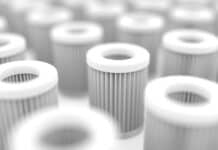Indigo-Clean is a registered trademark of Kenall Manufacturing Co., a Legrand company. Indigo-Clean® is a patented environmental disinfection technology that installs into overhead lighting to automatically and continuously disinfect the air and hard and soft surfaces. It is especially suited for entryways, waiting rooms, restrooms, or places that are difficult to clean continuously, and/or where pathogens are known to enter the facility.
 Using a patented blend of 405 nanometer indigo and white LED light, Indigo-Clean environmental disinfection technology bathes spaces in germ‑fighting protection. Due to the reflective nature of light, Indigo‑Clean reflects off walls and other surfaces to reach the many shadowed areas other disinfection technologies often miss. Once exposed, pathogens are oxidized from within, no matter where they exist. The dose index factor scientifically determines the necessary light coverage for the space based on the specific product type being installed.
Using a patented blend of 405 nanometer indigo and white LED light, Indigo-Clean environmental disinfection technology bathes spaces in germ‑fighting protection. Due to the reflective nature of light, Indigo‑Clean reflects off walls and other surfaces to reach the many shadowed areas other disinfection technologies often miss. Once exposed, pathogens are oxidized from within, no matter where they exist. The dose index factor scientifically determines the necessary light coverage for the space based on the specific product type being installed.
 Indigo-Clean environmental disinfection technology uses visible light, not UV. It is certified “Exempt” under the internationally recognized standard for safety: IEC 62471. This means that people can be in the space without exposure limits for any period of time.
Indigo-Clean environmental disinfection technology uses visible light, not UV. It is certified “Exempt” under the internationally recognized standard for safety: IEC 62471. This means that people can be in the space without exposure limits for any period of time.
Legrand recently announced the publication of research showing its Indigo-Clean light disinfection technology effectively and safely inactivates SARS-CoV-2 and influenza A viruses in a range of real-world clinical settings. This evidence was published in partnership with the Icahn School of Medicine at Mount Sinai.
The paper, “The virucidal effects of 405 nm visible light on SARS-CoV-2 and influenza A virus,” was published in Scientific Reports on September 30, 2021. It reflects how researchers evaluated the inactivation rate of the SARS-CoV-2 virus using 405 nm visible light under a range of clinical conditions. Kenall then applied these findings to a real-world usage model and determined that Indigo-Clean would achieve a SARS-CoV-2 inactivation rate of 94% based on 12 hours of occupied room use and 12 hours of unoccupied room use. The study was funded by Kenall.
“The findings from this research are critically important as the COVID-19 pandemic continues, flu season nears, and hospitals face increasing pressure to use every available space to provide care,” said Cliff Yahnke, Ph.D., Chief Scientist and Head of Clinical Affairs at Kenall. “Already proven to kill harmful bacteria, such as staph and MRSA, Indigo-Clean can be incorporated into any healthcare system’s mitigation strategy to help prevent infections, which leads to better health outcomes for patients and offers a return on investment in as little as 2.2 months.”
 Ultraviolet (UV) technologies have demonstrated the ability to reduce virological spread, but potential toxicities have limited its use in occupied spaces. Longer wavelengths with less irradiation energy, such as visible light (405 nanometers), have largely been evaluated in bactericidal and fungicidal applications. This research offers some of the strongest evidence to date of the real-world application of 405 nm visible light to inactivate the SARS-CoV-2 and influenza A viruses, helping to create safe, occupied spaces.
Ultraviolet (UV) technologies have demonstrated the ability to reduce virological spread, but potential toxicities have limited its use in occupied spaces. Longer wavelengths with less irradiation energy, such as visible light (405 nanometers), have largely been evaluated in bactericidal and fungicidal applications. This research offers some of the strongest evidence to date of the real-world application of 405 nm visible light to inactivate the SARS-CoV-2 and influenza A viruses, helping to create safe, occupied spaces.
“Reducing the ability of SARS-CoV-2 and influenza A to spread within healthcare settings is paramount,” said Adolfo Garcia-Sastre, Ph.D., Director of the Global Health & Emerging Pathogens Institute and Professor of Microbiology and Medicine at the Icahn School of Medicine at Mount Sinai and the study’s lead investigator. “This research adds important findings to the medical literature. It shows the potential of a simple, non-invasive technological solution to achieve inactivation of these highly disruptive viruses and warrants further evaluation across a range of additional clinical settings to further validate its effectiveness and safety.”





















![[VIDEO] Collect Asset Data at the Speed of Walking a Building](https://facilityexecutive.com/wp-content/uploads/2024/02/maxresdefault-324x160.jpg)